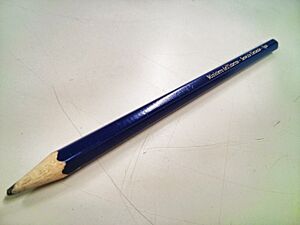Copying pencil facts for kids

A copying pencil is a special type of pencil that has a dye mixed into its lead. Unlike regular pencils, which use only graphite and clay, copying pencils add a dry dye that dissolves in water. This makes the marks they leave permanent and hard to erase. They are also known as indelible pencils or chemical pencils.
Contents
How Copying Pencils Changed History
Early Uses for Document Duplication
Copying pencils first appeared in the 1870s. They were originally made for copying important documents. Imagine you wrote a letter and needed an exact copy without a photocopier! People would write their document with a copying pencil. Then, they would place a damp, thin piece of tissue paper over the writing. By pressing down on it, the water-soluble dye would transfer from the original to the tissue paper. This created a mirror image copy. You could then hold the tissue paper up to a light to read the copy correctly.
Businesses widely used special "letter copying books" for this. These books had hundreds of thin pages, often made from high-quality Japanese paper. They were perfect for keeping copies of all the letters and documents a business sent out.
The Dye: Aniline and Its Color
The most common dye used in these pencils was called aniline. This dye usually made the writing look bright purple or mauve. The exact shade could vary depending on who made the pencil.
Becoming the Indelible Pencil
By the late 1800s, newer and better ways to copy documents became available. So, copying pencils started being used differently. They became known as "indelible pencils," which means "cannot be erased." They were a bit like an early version of the ball-point pen.
When used dry, they left a slightly purplish-gray mark, similar to a regular pencil. But you couldn't erase it! If you wet the tip of the pencil, perhaps with water or even saliva, it would make a bright purple mark. This made them a handy replacement for fountain-pens. You could carry one without needing a separate ink bottle or worrying about leaks.
Copying pencils were also great for making copies with carbon paper. They worked better than regular pencils because their writing couldn't be erased. They were also better than fountain pens, whose tips sometimes couldn't handle the pressure needed for carbon copies.
Widespread Use and Decline
Copying pencils were used a lot during World War I for all sorts of paperwork. However, when modern ballpoint pens became popular in the 1930s, the use of copying pencils slowly faded away in most parts of the world.
They did stick around longer in some places. For example, in countries like India and the Soviet Union, people often used them to write addresses on registered mail packages. These packages had to be wrapped in cloth, like plain white calico, and tied with string and sealing wax. A moistened copying pencil was perfect for writing on cloth because a pen's tip could easily get caught in the fabric.
During their most popular time, copying pencils were also famously associated with railway conductors around the world. Conductors often carried one tucked behind their ear!
Modern Uses Today
Even today, copying pencils are still used in some countries, like Italy. There, the law requires them for marking paper ballots in elections and referendums. The marks made with a copying pencil are very hard to change without leaving clear signs on the paper. This helps make sure votes are counted fairly and securely.
Health Risks: A Look Back
In the past, indelible pencils posed some health risks because of the aniline dyes they contained. If the dye from the pencil lead got into the body, for example, through a cut or a splinter, it could cause serious health problems. These included skin irritation, fever, and issues with blood, kidneys, and liver. The symptoms might not appear right away, sometimes taking weeks to show up.
It's important to remember that these risks were specific to the old aniline dyes. Modern pencils, including colored pencils, are made with different, safe materials and do not have these health concerns.
See Also


